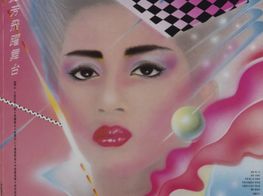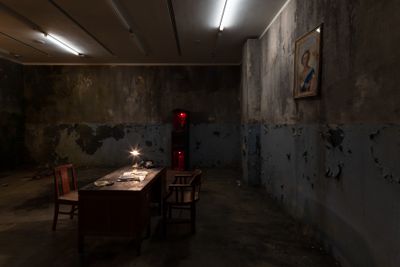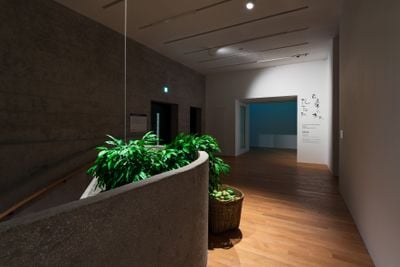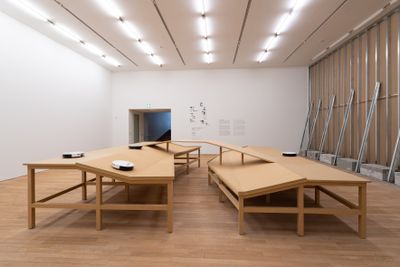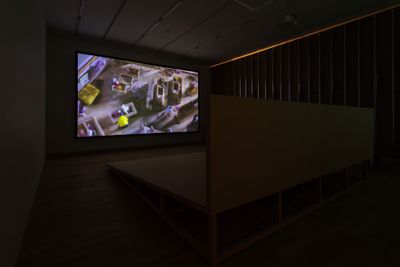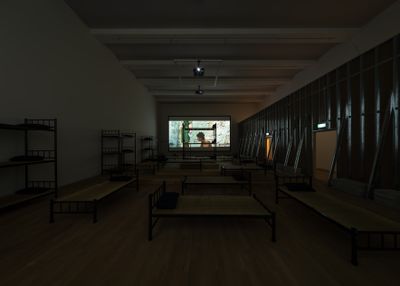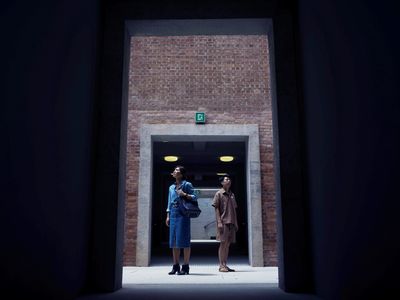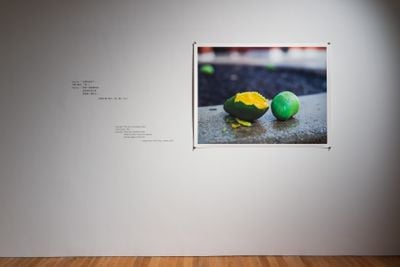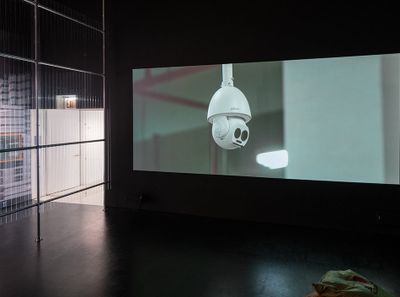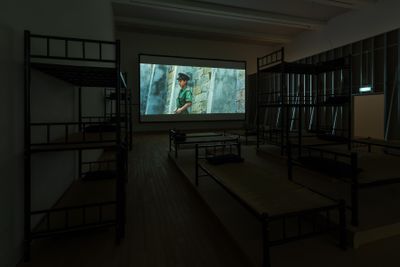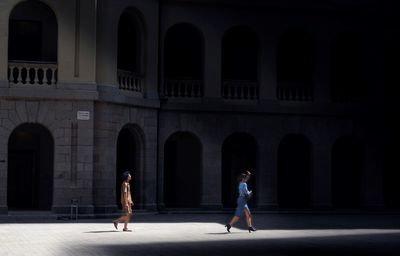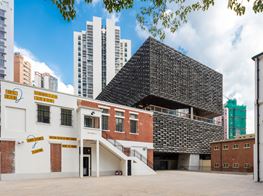Cao Fei
Cao Fei. Courtesy Tai Kwun Contemporary.
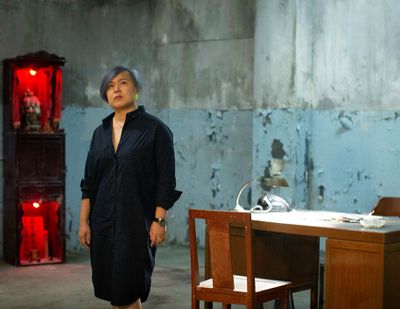
Cao Fei. Courtesy Tai Kwun Contemporary.
Cao Fei's first large-scale institutional exhibition in Asia, A hollow in a world too full (8 September 2018–4 January 2019), is taking place at Tai Kwun Contemporary in Hong Kong, the city's new non-profit art centre housed in a former colonial police and prison complex in Central. Organised in collaboration with Ullens Center for Contemporary Art (UCCA), the exhibition comprises an expansive multi-media installation that centres around Cao's especially commissioned new film, Prison Architect (2018).
Recorded on-site at Tai Kwun, Prison Architect follows a present-day architect (played by local actress Valerie Chow) as she is tasked with reverting the arts complex back into a prison. Scenes of the architect grappling with the ethics of designing a space for human captivity are interspersed with footage of a pensive male prisoner (a poet locked up during the 1968 anti-colonial riots and played by artist Kwan Sheung-chi), arousing a sense of pathos for the real detainees who once lived within Tai Kwun's restrictive boundaries. Viewers watch the film in a large room full of rudimentary prison cots upon which they are invited to rest.
Throughout the exhibition space, sets from the film's production are presented—including a room converted to resemble a damp, mossy prison office—among other earlier and unrelated video and installation works by Cao. Qu Chang, associate curator at the non-profit art institution Para Site in Hong Kong, spoke to Cao Fei on the occasion of the exhibition at Tai Kwun about her newly commissioned work, the current show, and her practice of late, including the film Asia One (2018), recently exhibited in the group exhibition One Hand Clappingat the Solomon R. Guggenheim Museum in New York (4 May–21 October 2018).
QCHow did you embark on the collaboration with Tai Kwun and UCCA?
CFWhen Tai Kwun contacted me, the project needed a collaborator, so they had a conversation with UCCA. Coincidentally, UCCA was planning to host my first solo exhibition in mainland China, so the two parties quickly agreed to co-curate the show. Because of the delay in Tai Kwun's construction, the exhibition was postponed to 2018, which was also very helpful for me, as it gave me more time for reflection.
Over the past three years, I've revisited the exhibition space several times. To start with, I had no idea such a place existed—it was a construction site back then. Twice a year, I would visit the site and pay close attention to its transformation. My views on the film and the exhibition, as well as of myself, have evolved over time. I'm still having conversations with the curator, and this has made us develop our perception of the whole project, which is an intriguing process in itself. We see too many exhibitions nowadays developed with a one-year production timeframe; prompt, efficient, purpose-driven. In contrast, the project took three years, which is a comparatively long process; long enough to allow an artist to develop and grow. At the same time, the transformation of the Tai Kwun complex itself allowed me enough time to digest its history—an organic process that allowed for the fermentation of creativity and contemplation.
QCSome of your previous works have been situated in Hong Kong or have referenced Hong Kong as a subject. What do you think of Prison Architect's relationship with the city? As a native Cantonese, how do you connect yourself with the exhibition site?
CFIt's actually not the first time I've exhibited in Hong Kong. In 2015, I was involved in the LED light project at the ICC (International Commerce Centre); and in 2013, I participated in the Mobile M+ exhibition, Inflation!. The work I exhibited was an inflated, gigantic suckling pig. Audience members queued to enter its body. I think the Hong Kong audience showed a deep understanding of the elements in my works, perhaps partly because I grew up in Guangzhou, a city that belongs to the Chinese 'Greater Bay Area', of which Hong Kong is a part.
So, Hong Kong culture is quite familiar to me. I grew up with its influential popular culture, and the language and the cuisine are similar. In terms of 'cultural differences', Beijing is more distant to me than Hong Kong.
From my perspective, subjects from around Hong Kong and the Pearl River Delta area are easier to deal with, because events here are very familiar to me. Tai Kwun's own history was unfamiliar to me to start with, but I was met with very few difficulties concerning the shooting space and cinematic language: an artist from the North would have to use Cantonese carefully to process the theme and language of the project, but the language barrier never existed for me. It would be like an artist from Chaoyang District conducting a project in Xicheng District: although they're geographically separated, these areas belong to the same cultural zone (both are districts in Beijing). The Tai Kwun project didn't imply an 'other' culture, and there was no need to painstakingly address the site-specificity: it was all natural to me.
QCI'm quite fond of the title of your exhibition, A hollow in a world too full. It echoes a theme in many of your works—that is, the construction of an imaginary yet realistic world. It's a good title for a retrospective show. But it seems that in comparison with your solo exhibition at MoMA PS1 in 2016, the body of works at Tai Kwun does not seem sufficient to make up a retrospective. What was your approach to selecting pieces?
CFAlthough this is my first major solo exhibition in Asia, this is not a retrospective show. In addition, the gallery space at Tai Kwun is even bigger than that of PS1. When it came to selecting specific pieces, I discussed with the curator Xue Tan quite a lot, and we agreed that there was no need to fill up the whole space. Neither of us intended to create a typical, visually intense 'Cao Fei Exhibition' with many screens and videos. We hoped to endow the space with something unseen, to consciously avoid the typical reading that people have of my work. The curator and I put a lot of effort into adding air and space to allow a sense of flow to emerge.
We also paid attention to interweaving the newly commissioned project with the rest of the show, rather than simply putting on a 'retrospective'. So, the impression of 'retrospective' should be replaced with the word 'project'. Furthermore, many people see my work as being very much focused on contemporary China, containing themes such as urbanisation and social transition. This exhibition, however, showcases the videos i.Mirror (2007), La Town (2014), and Prison Architect—none of which directly discuss urbanisation or modernity; rather, they omit any specific social context. Moreover, what they all have in common is that they contain a dialogue between a male and a female, though they are dialogues that don't necessarily fall into the 'love' category. One couple is in a virtual city, another is located in a virtual town constructed by computational models, and another exists between past and present conversations. This is something I'd like to propose: a subtle clue of the artist's emotion and sensitivity, one that's often hidden by grander narratives.
In the exhibition, there are three conversations existing among three groups of males and females, who are not necessarily in romantic relationships. In La Town, the protagonists are invisible, and all we can experience are their voices talking about love, the city, and the apocalypse; in i.Mirror, there is no 'love story' between the two avatars. Prison Architect, on the other hand, features a conversation across space-time, a conversation with no romantic ambiguity. This can be seen as part of the approach to selecting artworks—an approach that also included some subtle treatment of the space and the installation: the moss on the walls, the rough texture of cement, and the performances. In the process of wandering and viewing, all these details dissolve the audience's assumptions about so-called 'exhibition spaces'. When working with the exhibition space, I consciously maintain the visibility of the artworks within the space's atmosphere, allowing the audience to forget the texture and supreme tone of the gallery space. The exhibition walls are also processed in a way that echoes the space itself, as if historical memories embedded and buried begin to re-emerge.
Tai Kwun's architects, Herzog & de Meuron, decided to 'insert' Tai Kwun Contemporary into the former Victorian prison complex, without feeling too obliged towards its history. I think many proposals were made before they arrived at the decision to create a rather 'obtrusive' space that was free from pre-set discourses—perhaps to be free from literal contexts, or perhaps because the building no longer needs to maintain the prison's original nature under British colonialism. Windows are minimal in the space, which is typical of an art museum. I was quite uncertain at the beginning; thus, I allow a lot of the old memories and personal histories slowly yet unceasingly permeate the show.
QCDuring the credits of Prison Architect, it's mentioned that you took inspiration from the short story The Consolation of Imprisonment by Hu Fang, the novelist and curator who co-founded Vitamin Space in Guangzhou. How is the story re-written and integrated into your piece?
CFI only came across this text last year, but even still, it guided the tone and the direction of the film somehow. The novel investigates all kinds of prisons and humanity's perception of imprisonment; it asks what the objective of captivity is, and how to understand it from a non-confrontational perspective. The book analyses the purposes and structures of numerous prisons from various times and places. I incorporated my reflections on this book into the history of Tai Kwun, and added layers such as the protagonists, the time-space, and the historical context of Hong Kong. The process broadened my understanding of 'prison', and rather than brutally categorise 'prison' as a kind of violence, I began to gradually understand it as a wider spectrum. I contemplated how we live with the notion of 'imprisonment'—imprisonment in a physical cell, 'non-prison' prisons, and a prison transformed into a cultural centre. From this, the role of an architect emerged, and it's through this perspective that viewers are guided into the film and encouraged to digest the space and its history.
There are some other texts you can see in the film—for instance, an anthology of poems titled the Gulf, written by a prisoner. After the screening at the opening of the show, Hu Fang asked me about the author of this anthology. I laughed—it's entirely fictional.
QCThe idea of 'prison', or what you could call a 'prison perspective', is a subtle theme in many of your works, including the cell-like dorms in the video Imbalance 257 (1999) and the panoception virtual city in i.Mirror. In Prison Architect, the hidden narrative became a subject matter. How has this evolved?
CFThere are some references quoted on the exhibition wall. For instance, when you leave the room where my performance Coming Soon is exhibited, you encounter a quote taken from my 2007 piece, i.Mirror. In this piece, my avatar China Tracy has a conversation with a male avatar, Hug Yue. It was an actual dialogue between my avatar and Hug Yue in the online virtual world Second Life. The real Hug Yue is an old guy living in the US—an enthusiastic communist who's deeply fond of Karl Marx's theories. He was jailed in the 1970s for robbing a bank in an attempt to gather 'revolution capital'. It was a fascinating story to me: China Tracy comes across a handsome male avatar who was an old man in real life, an old man who was imprisoned but who remained an idealist. In our conversation, he yearned for freedom, as he'd never been transformed by society—all the 'transformations' prepared for him took place in jail.
After he was set free, he wasn't in step with society. Already an old man, he was obsessed with Second Life and poetry; even a digital sunrise would make him sigh. As you mentioned before, elements of 'imprisonment' are consistent throughout my oeuvre, and they appear at the end of Prison Architect. I like the way you suggest that it emerges from a 'hidden narrative', it really connects to the history of the prison itself. Some people think the piece was created to promote Tai Kwun, which I find ridiculous, though I can't help what people think. On one hand, the Tai Kwun project doesn't need my promotion. On the other hand, making works at its real location has been important to me. For instance, in Asia One, we went to the logistics company JD and shot on-site, although the easier option would have been to rent a similar place to do the shooting, as is often done in the film industry. But we chose to shoot on-site, even though it meant we had to look for support from JD and gain their permission. We did, and the miracle happened.
i.Mirror was also developed on top of a real structure, and the video Whose Utopia (2006), was created in the Siemens factories in Foshan, Guangdong. You could say that the Tai Kwun commission aligns with my work pattern of basing the creative part on reality—a fictional telling on top of a real structure. The shooting of Prison Architect was finished before the venue was open to the public—partly because I wanted to freeze-frame the state of a place like that, through an artwork, before tourists flooded in. How many chances exist to create a piece in a real jail? The commission was a valuable chance for me. On-site shooting was the crucial part—of course we could have re-constructed a cell elsewhere, but what's the point of doing that? Prison Architect differs from my previous works in that it involves space, texture, professional actors, and performances staged by artist groups. Yet the structure I created wasn't overly transparent; there are no explicit historical references to the prison. I think the overall tone creates a reflective scenario.
QCYour works are often very literary. How do writing and creative work go hand in hand in your practice?
CFLa Town's root in literature is Marguerite Duras's Hiroshima Mon Amour, while i.Mirror is based on excerpts from a conversation I had with a friend—an edited version, of course, but 70 to 80 percent of it is based on the original conversation. I enjoy text as a form, but—like my criteria for moving images or other forms of art, I'm quite selective. In other words, the texts or artworks that I find truly, deeply moving, are rare. Back in 2000, before Hu Fang co-founded Vitamin Space, I'd already read his novels. He was a finance editor for some newspaper in Guangzhou, and novel writing was only a hobby for him. At that time, I wrote an email to him and expressed my appreciation for his writing. I said, 'Your novels are indeed great, they inspire me to write.' I was only a recent graduate back then, who was interested in literature.
Personally speaking, I've always enjoyed writing. Recently, due to tight schedules, my time spent on writing has been limited: sometimes I write around 100 words on Weibo, or some short texts on WeChat. The publication, Cao Fei: Splendid River – A text and drawing book, which was released in 2015, can be viewed as my notes on daily observations in recent years. Similar to Antonioni, I never call my notes 'scripts'. His director notes are fascinating, but rarely recreated as films—I actually prefer reading his notes. I resonate with the way he observes: overhearing, peeping, extracting, profiling from real life, and developing fiction or letting the imagination go on these subjects. Methodologies like this have a dimension in real life and aren't purely fictional. Instead, they're engulfed in curiosity for real life.
QCPrison Architect and Asia One were both made in 2018. Both are large-scale pieces. Could you describe the timeline of creating these two pieces?
CFThe Tai Kwun project was commissioned a bit earlier, but its real starting point was roughly at the same time as Asia One—both in 2017. In fact, I'm quite used to running parallel projects, but the time of completion might vary. There was an overlapping period of work on the two pieces during the last one or two years.
Asia One is a gigantic work, with an accompanying full-length documentary film. The two pieces focus on different themes and use different visual styles; those who have seen both can easily tell the difference. I spent last November and December shooting Asia One, and it was only completed at the end of April, right before One Hand Clapping opened at the Guggenheim. I spent three days in New York after the opening, and then flew to Hong Kong for the shooting of Prison Architect. I appreciate the local production team in Hong Kong and Tai Kwun's project team, who were extremely professional in conducting early-stage research, which made for a smooth shooting process. Nevertheless, it was still very hard work—we worked around the clock till the last minute before the show opened. The director of photography, Pung-Leung Kwan, stayed in close discussion with me regarding the imagery, colour, and editing of the film—a truly respectful man.
Asia One is a clear emotional story, which features a triangular relationship between a girl, a boy, and a bot, who work at a fully automated distribution centre. The three individuals stand in for an entanglement between the existence of humans, the absence of humans, and the 'non-human'. The 'non-human' refers to robotics, 'the absence of humans' points to automated production, and 'human' relates to the workers in this context, or to a larger degree, the human species. Precisely because of their spatial separation, the male and female figures are eager to get closer. Many details can be seen in this piece: it interweaves historical elements, such as excerpts from On the Docks, one of the eight Chinese 'model plays' during the Cultural Revolution. This approach of 'implanting' can also be seen in Prison Architect. After seeing Asia One, the philosopher Yuk Hui stated that the level of historicity and temporality in this piece hasn't been seen in my previous works.
QCYou recently co-curated a group exhibition with Yang Beichen titled New Metallurgists at Julia Stoschek Collection in Düsseldorf (7 October 2018–28 April 2019). How was that?
CFYang has done tremendous work in going through artists' information and related articles, whereas I contributed more from an artistic perspective by providing spatial references for the exhibition layout, along with contextual relationships among works. The exhibiting artists are very young, but most of them have studied overseas or done residencies. As a result, the pool of artists is less 'Chinese' in terms of their cultural or geographical backgrounds; they are a nomadic group. My upbringing is still very much rooted in China, but for artists like Shen Xin who shoots in Thailand, or Fang Di who's often in Los Angeles, their subjects and artistic languages tend to be richer and freer.
It's incredibly hard nowadays to give an overview of 'young Chinese artists'. Since 2000, there have been various Chinese contemporary art exhibitions in the West. It was quite a vigorous scene with a clear outline of the overall situation. However, in the past few years, survey exhibitions like these have become rare, so I believe the show in Germany is a good chance to present the work of a group of artists. The show mixes their oeuvres, and anticipates the development of this generation of moving image artists. —[O]


